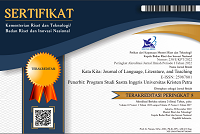Adopting and Challenging Traditional Gender Roles in 90s Sitcom Friends
DOI:
https://doi.org/10.9744/katakita.10.2.252-260Keywords:
otomotif, knalpot racing, valvetronikAbstract
Sitcom has been worldwide famous since the 1950s. Friends is one of the most well-known sitcoms, telling the story of friends who lived in New York City during their youth. I will analyze gender roles issues in Friends. In this study, I will analyze how the six main characters adopt traditional gender roles and how the six main characters eventually challenge them. I use several theories, such as traits of traditional gender roles, theory of gender roles orientation, and theory of egalitarianism. My analysis demonstrates that each of the six main characters adopted at least one trait of traditional gender roles at the beginning of the series. The traits they adopted will be categorized by their personal attitude, social behavior, value, self-concept, and career choice. By the end of the series, the six main characters had eventually challenged traditional gender roles and adopted more to the Egalitarianism theory.
References
Beutel, A., & Marini, M. (1995). Gender and values. 60(3), 436. American Sociological Review. https://doi.org/10.2307/2096423
Dalton, M., & Linder, L. (2005). The sitcom reader. State University of New York Press.
David, D., & Brannon R. (1976). The forty-nine percent majority, p.12.
Lorber, J. (1994). Paradoxes of gender. Yale University Press.
Marshall, L. (2007). “I'll be there for you" if you are just like me: an analysis of hegemonic social structure in “Friends” (Doctor of Philosophy). Graduate College of Bowling Green.
Mendrinos, J. (2004). The complete idiot’s guide to comedy writing (p.229). Marie-Butler Knight.
Money, J., Hampson, J.G., & Hampson, J. L. (1955). An examination of some basic sexual concept: The evidence of human hermaphroditism (97, 301-319). Bulletin of the Johns Hopkins Hospital.
The 100 best TV shows of all-time. (2009). Time. https://web.archive.org/web/20090224154857/http://www.time.com/time/specials/2007/0,28757,1651341,00.html.
Wamsler, I. (2007). History and characteristics of US-sitcoms. GRIN Verlag. https://www.grin.com/document/284775.
Welter, B. (1996). The cult of true Womanhood: 1820-1860 (18(2), 151-174). American Quarterly. https://doi.org/10.2307/2711179
Downloads
Published
Issue
Section
License
Authors who publish with this journal agree to the following terms:- Authors retain copyright and grant the journal right of first publication with the work simultaneously licensed under a Creative Commons Attribution License that allows others to share the work with an acknowledgement of the work's authorship and initial publication in this journal.
- Authors are able to enter into separate, additional contractual arrangements for the non-exclusive distribution of the journal's published version of the work (e.g., post it to an institutional repository or publish it in a book), with an acknowledgement of its initial publication in this journal.
- Authors are permitted and encouraged to post their work online (e.g., in institutional repositories or on their website) prior to and during the submission process, as it can lead to productive exchanges, as well as earlier and greater citation of published work (See The Effect of Open Access).














